The Cambridge History of Japan, Vol. 4: Early Modern Japan
Подождите немного. Документ загружается.

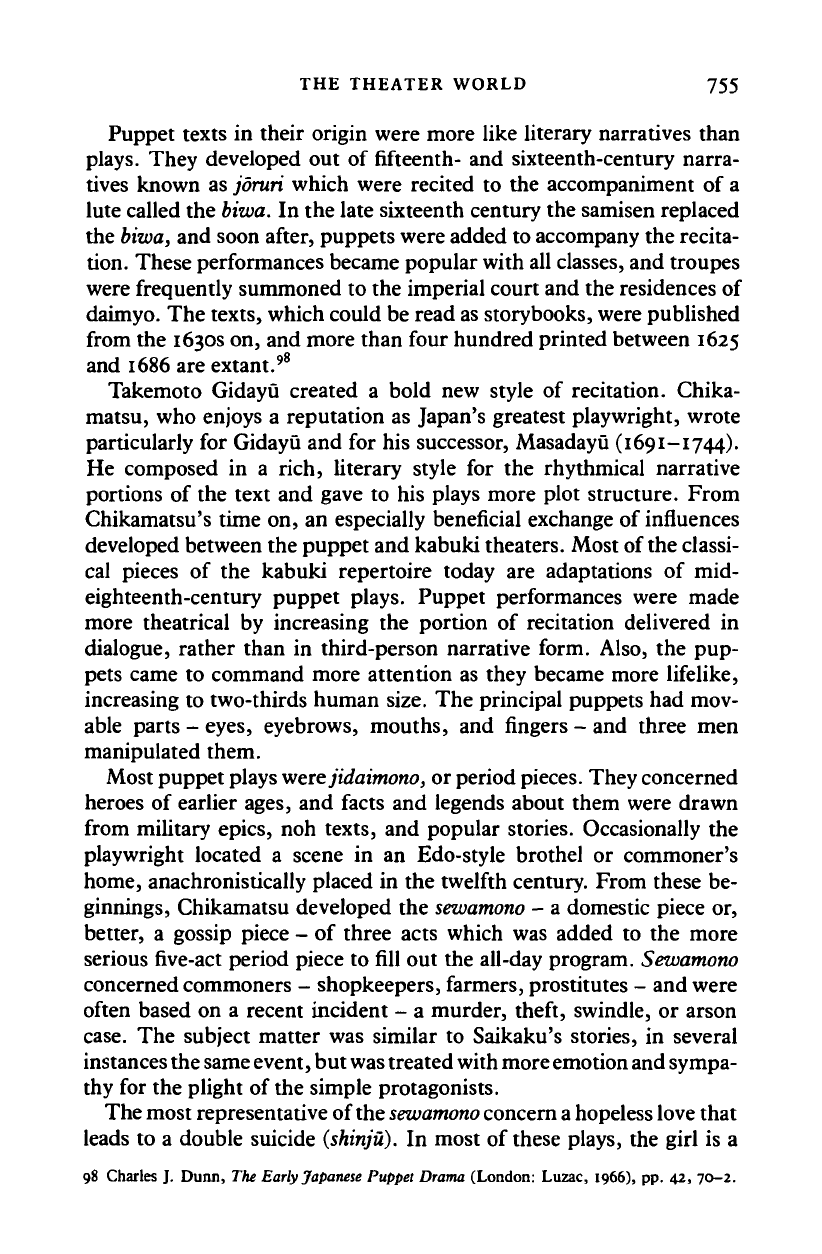
THE THEATER WORLD 755
Puppet texts in their origin were more like literary narratives than
plays.
They developed out of fifteenth- and sixteenth-century narra-
tives known as
joruri
which were recited to the accompaniment of a
lute called the
biwa.
In the late sixteenth century the samisen replaced
the
biwa,
and soon after, puppets were added to accompany the recita-
tion. These performances became popular with all classes, and troupes
were frequently summoned to the imperial court and the residences of
daimyo. The texts, which could be read as storybooks, were published
from the 1630s on, and more than four hundred printed between 1625
and 1686 are extant.
98
Takemoto Gidayu created a bold new style of recitation. Chika-
matsu, who enjoys a reputation as Japan's greatest playwright, wrote
particularly for Gidayu and for his successor, Masadayu (1691-1744).
He composed in a rich, literary style for the rhythmical narrative
portions of the text and gave to his plays more plot structure. From
Chikamatsu's time on, an especially beneficial exchange of influences
developed between the puppet and kabuki theaters. Most of
the
classi-
cal pieces of the kabuki repertoire today are adaptations of mid-
eighteenth-century puppet plays. Puppet performances were made
more theatrical by increasing the portion of recitation delivered in
dialogue, rather than in third-person narrative form. Also, the pup-
pets came to command more attention as they became more lifelike,
increasing to two-thirds human size. The principal puppets had mov-
able parts - eyes, eyebrows, mouths, and fingers - and three men
manipulated them.
Most puppet plays were
jidaimono,
or period
pieces.
They concerned
heroes of earlier ages, and facts and legends about them were drawn
from military epics, noh texts, and popular stories. Occasionally the
playwright located a scene in an Edo-style brothel or commoner's
home, anachronistically placed in the twelfth century. From these be-
ginnings, Chikamatsu developed the
sewamono
- a domestic piece or,
better, a gossip piece - of three acts which was added to the more
serious five-act period piece to fill out the all-day program.
Sewamono
concerned commoners - shopkeepers, farmers, prostitutes - and were
often based on a recent incident - a murder, theft, swindle, or arson
case.
The subject matter was similar to Saikaku's stories, in several
instances the same event, but
was
treated with more emotion and sympa-
thy for the plight of the simple protagonists.
The most representative of the
sewamono
concern
a
hopeless love that
leads to a double suicide
(shinju).
In most of these plays, the girl is a
98 Charles J. Dunn, The Early Japanese Puppet Drama (London: Luzac, 1966), pp. 42, 70-2.
Cambridge Histories Online © Cambridge University Press, 2008
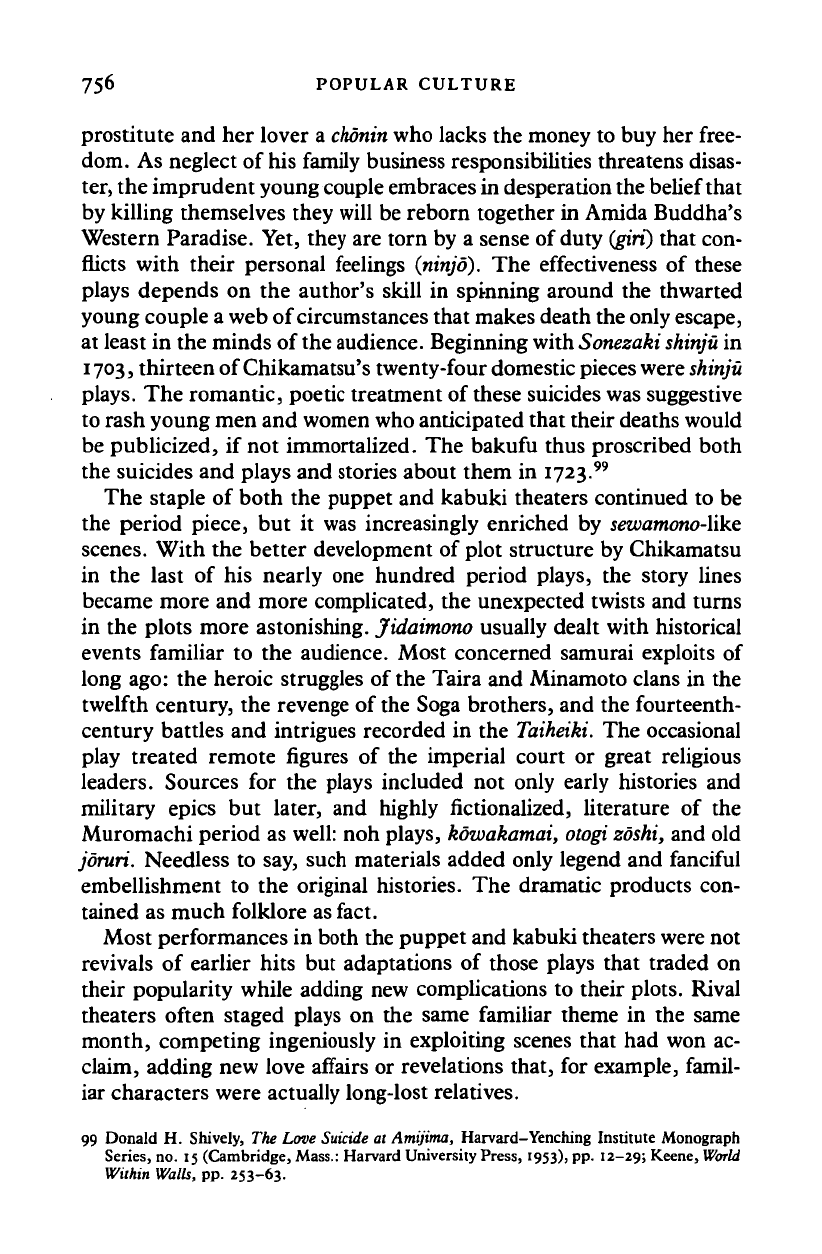
756 POPULAR CULTURE
prostitute and
her
lover
a
chonin
who lacks the money
to
buy her free-
dom. As neglect
of
his family business responsibilities threatens disas-
ter, the imprudent young
couple
embraces in desperation the belief that
by killing themselves they will be reborn together in Amida Buddha's
Western Paradise. Yet, they are torn by
a
sense
of
duty
{girt)
that con-
flicts with their personal feelings (ninjo).
The
effectiveness
of
these
plays depends
on the
author's skill
in
spinning around
the
thwarted
young couple a web of circumstances that makes death the only escape,
at least in the minds of the audience. Beginning with
Sonezaki shinju
in
1703,
thirteen of Chikamatsu's twenty-four domestic pieces were
shinju
plays.
The romantic, poetic treatment
of
these suicides was suggestive
to rash young men and women who anticipated that their deaths would
be publicized,
if
not immortalized.
The
bakufu thus proscribed both
the suicides and plays and stories about them
in
1723."
The staple
of
both
the
puppet and kabuki theaters continued
to be
the period piece,
but it
was increasingly enriched
by
sewamono-like
scenes. With
the
better development
of
plot structure by Chikamatsu
in
the
last
of his
nearly
one
hundred period plays,
the
story lines
became more
and
more complicated, the unexpected twists
and
turns
in
the
plots more astonishing. Jidaimono usually dealt with historical
events familiar
to the
audience. Most concerned samurai exploits
of
long ago:
the
heroic struggles
of
the Taira and Minamoto clans
in the
twelfth century, the revenge
of
the Soga brothers, and the fourteenth-
century battles
and
intrigues recorded
in the
Taiheiki.
The occasional
play treated remote figures
of the
imperial court
or
great religious
leaders. Sources
for the
plays included
not
only early histories
and
military epics
but
later,
and
highly fictionalized, literature
of the
Muromachi period
as
well: noh plays, kowakamai,
otogi
zoshi,
and old
joruri. Needless
to
say, such materials added only legend
and
fanciful
embellishment
to the
original histories.
The
dramatic products
con-
tained
as
much folklore as fact.
Most performances in both the puppet and kabuki theaters were not
revivals
of
earlier hits
but
adaptations
of
those plays that traded
on
their popularity while adding new complications
to
their plots. Rival
theaters often staged plays
on the
same familiar theme
in the
same
month, competing ingeniously
in
exploiting scenes that
had
won
ac-
claim, adding new love affairs
or
revelations that,
for
example, famil-
iar characters were actually long-lost relatives.
99 Donald
H.
Shively, The Love Suicide
at
Amijima, Harvard-Yenching Institute Monograph
Series, no. 15 (Cambridge, Mass.: Harvard University Press, 1953), pp. 12-29; Keene,
World
Within
Walls,
pp. 253-63.
Cambridge Histories Online © Cambridge University Press, 2008
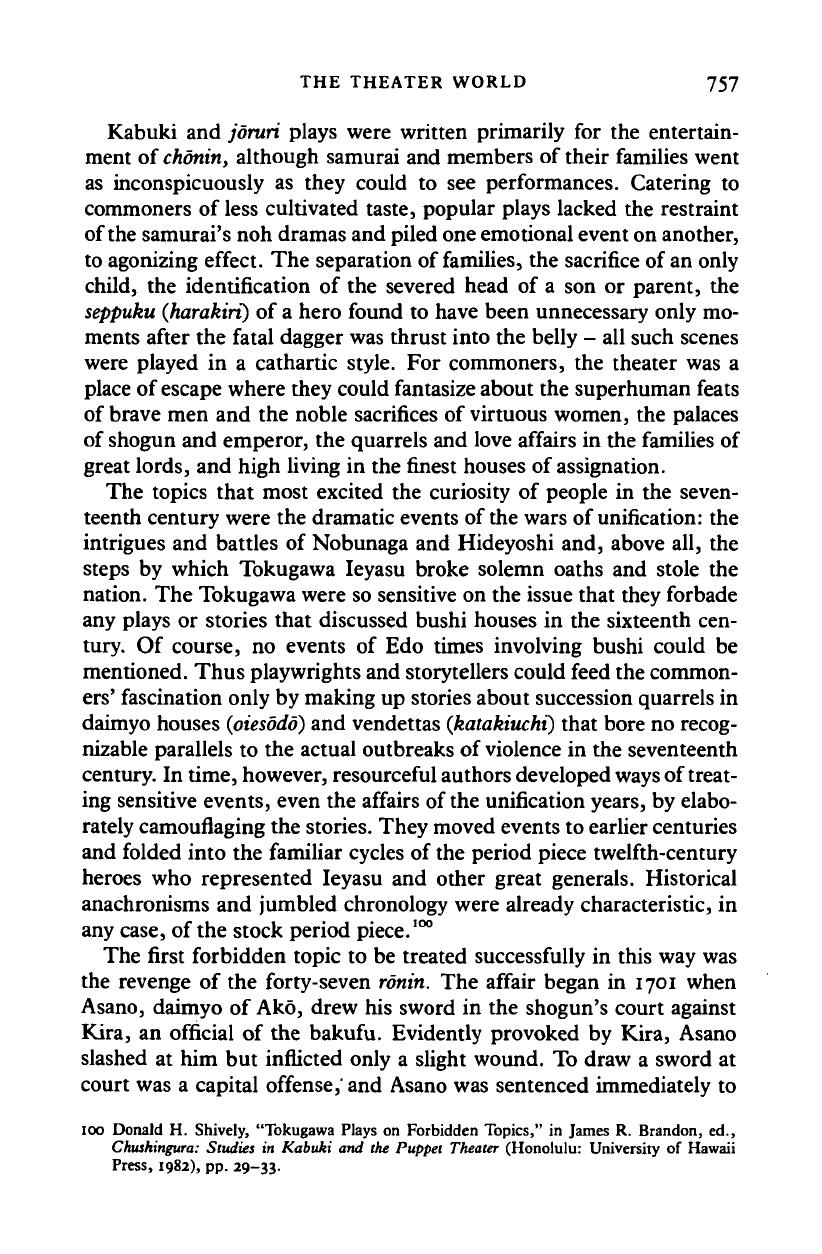
THE THEATER WORLD 757
Kabuki and
joruri
plays were written primarily for the entertain-
ment of
chonin,
although samurai and members of their families went
as inconspicuously as they could to see performances. Catering to
commoners of less cultivated taste, popular plays lacked the restraint
of the samurai's noh dramas and piled one emotional event on another,
to agonizing effect. The separation of families, the sacrifice of an only
child, the identification of the severed head of a son or parent, the
seppuku (harakiri)
of a hero found to have been unnecessary only mo-
ments after the fatal dagger was thrust into the belly - all such scenes
were played in a cathartic style. For commoners, the theater was a
place of escape where they could fantasize about the superhuman feats
of brave men and the noble sacrifices of virtuous women, the palaces
of shogun and emperor, the quarrels and love affairs in the families of
great lords, and high living in the finest houses of assignation.
The topics that most excited the curiosity of people in the seven-
teenth century were the dramatic events of the wars of unification: the
intrigues and battles of Nobunaga and Hideyoshi and, above all, the
steps by which Tokugawa Ieyasu broke solemn oaths and stole the
nation. The Tokugawa were so sensitive on the issue that they forbade
any plays or stories that discussed bushi houses in the sixteenth cen-
tury. Of course, no events of Edo times involving bushi could be
mentioned. Thus playwrights and storytellers could feed the common-
ers'
fascination only by making up stories about succession quarrels in
daimyo houses
(otesodo)
and vendettas
(katakiuchi)
that bore no recog-
nizable parallels to the actual outbreaks of violence in the seventeenth
century. In time, however, resourceful authors developed
ways
of treat-
ing sensitive events, even the affairs of the unification years, by elabo-
rately camouflaging the stories. They moved events to earlier centuries
and folded into the familiar cycles of the period piece twelfth-century
heroes who represented Ieyasu and other great generals. Historical
anachronisms and jumbled chronology were already characteristic, in
any case, of the stock period piece.
100
The first forbidden topic to be treated successfully in this way was
the revenge of the forty-seven
ronin.
The affair began in 1701 when
Asano, daimyo of Ako, drew his sword in the shogun's court against
Kira, an official of the bakufu. Evidently provoked by Kira, Asano
slashed at him but inflicted only a slight wound. To draw a sword at
court was a capital offense,' and Asano was sentenced immediately to
100 Donald H. Shively, "Tokugawa Plays on Forbidden Topics," in James R. Brandon, ed.,
Chushingura:
Studies in Kabuki and the Puppet Theater (Honolulu: University of Hawaii
Press,
1982), pp. 29-33.
Cambridge Histories Online © Cambridge University Press, 2008
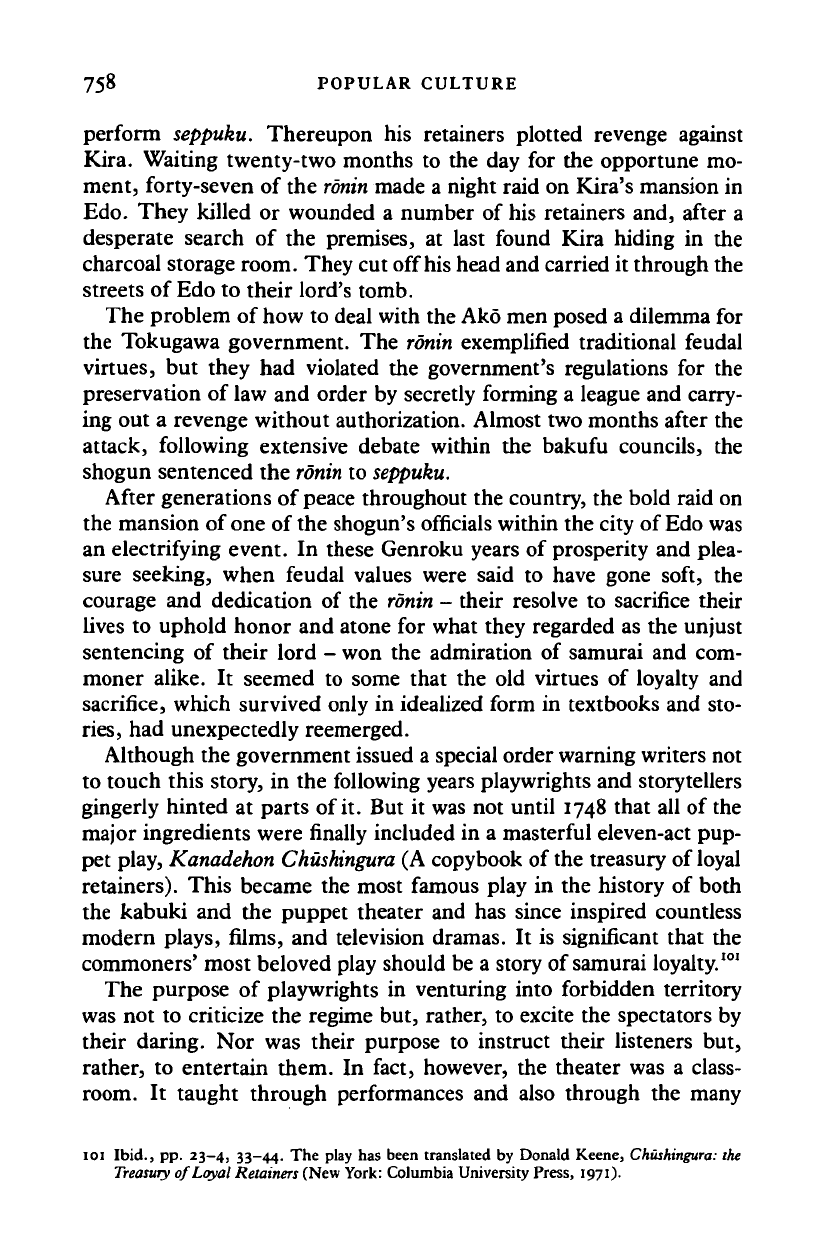
758 POPULAR CULTURE
perform seppuku. Thereupon his retainers plotted revenge against
Kira. Waiting twenty-two months to the day for the opportune mo-
ment, forty-seven of the
ronin
made a night raid on Kira's mansion in
Edo.
They killed or wounded a number of his retainers and, after a
desperate search of the premises, at last found Kira hiding in the
charcoal storage room. They cut off his head and carried it through the
streets of Edo to their lord's tomb.
The problem of how to deal with the Ako men posed a dilemma for
the Tokugawa government. The
ronin
exemplified traditional feudal
virtues, but they had violated the government's regulations for the
preservation of law and order by secretly forming a league and carry-
ing out a revenge without authorization. Almost two months after the
attack, following extensive debate within the bakufu councils, the
shogun sentenced the
ronin
to
seppuku.
After generations of peace throughout the country, the bold raid on
the mansion of one of the shogun's officials within the city of
Edo
was
an electrifying event. In these Genroku years of prosperity and plea-
sure seeking, when feudal values were said to have gone soft, the
courage and dedication of the
ronin
- their resolve to sacrifice their
lives to uphold honor and atone for what they regarded as the unjust
sentencing of their lord - won the admiration of samurai and com-
moner alike. It seemed to some that the old virtues of loyalty and
sacrifice, which survived only in idealized form in textbooks and sto-
ries,
had unexpectedly reemerged.
Although the government issued a special order warning writers not
to touch this story, in the following years playwrights and storytellers
gingerly hinted at parts of
it.
But it was not until 1748 that all of the
major ingredients were finally included in a masterful eleven-act pup-
pet play,
Kanadehon Chushingura
(A copybook of the treasury of loyal
retainers). This became the most famous play in the history of both
the kabuki and the puppet theater and has since inspired countless
modern plays, films, and television dramas. It is significant that the
commoners' most beloved play should be a story of samurai loyalty.
101
The purpose of playwrights in venturing into forbidden territory
was not to criticize the regime but, rather, to excite the spectators by
their daring. Nor was their purpose to instruct their listeners but,
rather, to entertain them. In fact, however, the theater was a class-
room. It taught through performances and also through the many
101 Ibid., pp. 23-4, 33-44. The play has been translated by Donald Keene,
Chushingura:
the
Treasury
of Loyal Retainers (New York: Columbia University Press, 1971).
Cambridge Histories Online © Cambridge University Press, 2008
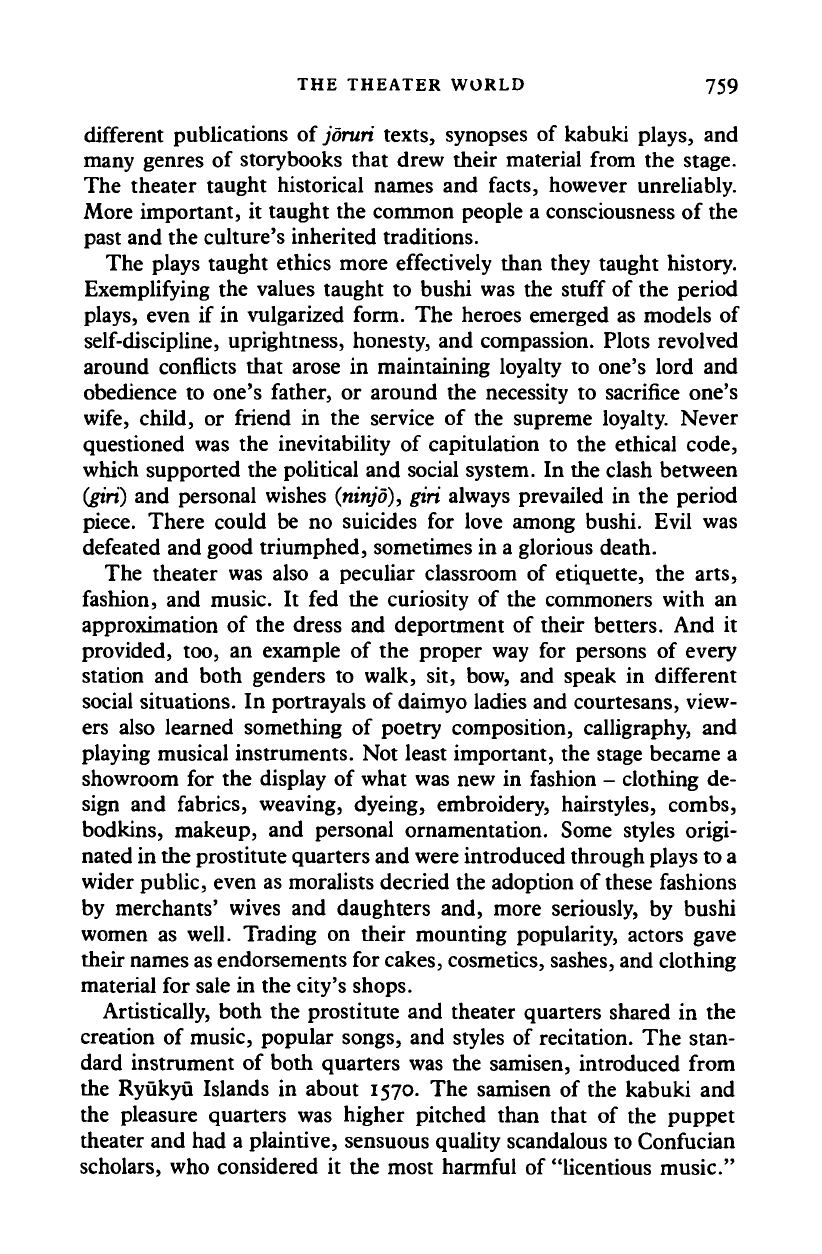
THE THEATER WORLD 759
different publications of
joruri
texts, synopses of kabuki plays, and
many genres of storybooks that drew their material from the stage.
The theater taught historical names and facts, however unreliably.
More important, it taught the common people a consciousness of the
past and the culture's inherited traditions.
The plays taught ethics more effectively than they taught history.
Exemplifying the values taught to bushi was the stuff of the period
plays,
even if in vulgarized form. The heroes emerged as models of
self-discipline, uprightness, honesty, and compassion. Plots revolved
around conflicts that arose in maintaining loyalty to one's lord and
obedience to one's father, or around the necessity to sacrifice one's
wife,
child, or friend in the service of the supreme loyalty. Never
questioned was the inevitability of capitulation to the ethical code,
which supported the political and social system. In the clash between
(girt)
and personal wishes
(ninjo),
giri always prevailed in the period
piece. There could be no suicides for love among bushi. Evil was
defeated and good triumphed, sometimes in a glorious death.
The theater was also a peculiar classroom of etiquette, the arts,
fashion, and music. It fed the curiosity of the commoners with an
approximation of the dress and deportment of their betters. And it
provided, too, an example of the proper way for persons of every
station and both genders to walk, sit, bow, and speak in different
social situations. In portrayals of daimyo ladies and courtesans, view-
ers also learned something of poetry composition, calligraphy, and
playing musical instruments. Not least important, the stage became a
showroom for the display of what was new in fashion - clothing de-
sign and fabrics, weaving, dyeing, embroidery, hairstyles, combs,
bodkins, makeup, and personal ornamentation. Some styles origi-
nated in the prostitute quarters and were introduced through plays to a
wider public, even as moralists decried the adoption of these fashions
by merchants' wives and daughters and, more seriously, by bushi
women as well. Trading on their mounting popularity, actors gave
their names as endorsements for cakes, cosmetics, sashes, and clothing
material for sale in the city's shops.
Artistically, both the prostitute and theater quarters shared in the
creation of music, popular songs, and styles of recitation. The stan-
dard instrument of both quarters was the samisen, introduced from
the Ryukyu Islands in about 1570. The samisen of the kabuki and
the pleasure quarters was higher pitched than that of the puppet
theater and had a plaintive, sensuous quality scandalous to Confucian
scholars, who considered it the most harmful of "licentious music."
Cambridge Histories Online © Cambridge University Press, 2008
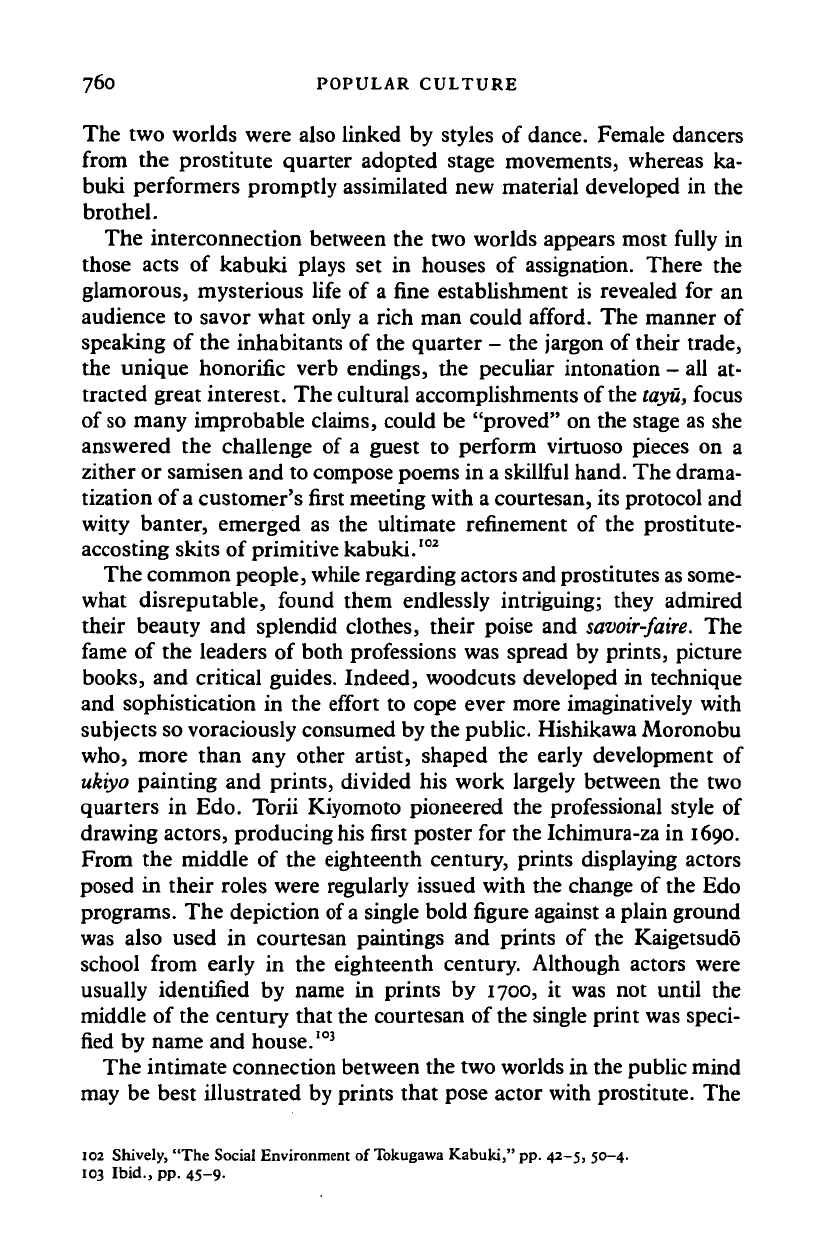
76O POPULAR CULTURE
The two worlds were also linked by styles of dance. Female dancers
from the prostitute quarter adopted stage movements, whereas ka-
buki performers promptly assimilated new material developed in the
brothel.
The interconnection between the two worlds appears most fully in
those acts of kabuki plays set in houses of assignation. There the
glamorous, mysterious life of a fine establishment is revealed for an
audience to savor what only a rich man could afford. The manner of
speaking of the inhabitants of the quarter - the jargon of their trade,
the unique honorific verb endings, the peculiar intonation - all at-
tracted great interest. The cultural accomplishments of
the
tayu,
focus
of
so
many improbable claims, could be "proved" on the stage as she
answered the challenge of a guest to perform virtuoso pieces on a
zither or samisen and to compose poems in a skillful hand. The drama-
tization of a customer's first meeting with a courtesan, its protocol and
witty banter, emerged as the ultimate refinement of the prostitute-
accosting skits of primitive kabuki.
102
The common people, while regarding actors and prostitutes as some-
what disreputable, found them endlessly intriguing; they admired
their beauty and splendid clothes, their poise and
savoir-faire.
The
fame of the leaders of both professions was spread by prints, picture
books, and critical guides. Indeed, woodcuts developed in technique
and sophistication in the effort to cope ever more imaginatively with
subjects so voraciously consumed by the public. Hishikawa Moronobu
who,
more than any other artist, shaped the early development of
ukiyo painting and prints, divided his work largely between the two
quarters in Edo. Torii Kiyomoto pioneered the professional style of
drawing actors, producing his first poster for the Ichimura-za in 1690.
From the middle of the eighteenth century, prints displaying actors
posed in their roles were regularly issued with the change of the Edo
programs. The depiction of
a
single bold figure against a plain ground
was also used in courtesan paintings and prints of the Kaigetsudo
school from early in the eighteenth century. Although actors were
usually identified by name in prints by 1700, it was not until the
middle of the century that the courtesan of the single print was speci-
fied by name and house.
103
The intimate connection between the two worlds in the public mind
may be best illustrated by prints that pose actor with prostitute. The
102 Shively, "The Social Environment of Tokugawa Kabuki," pp. 42-5, 50-4.
103 Ibid., pp. 45-9.
Cambridge Histories Online © Cambridge University Press, 2008
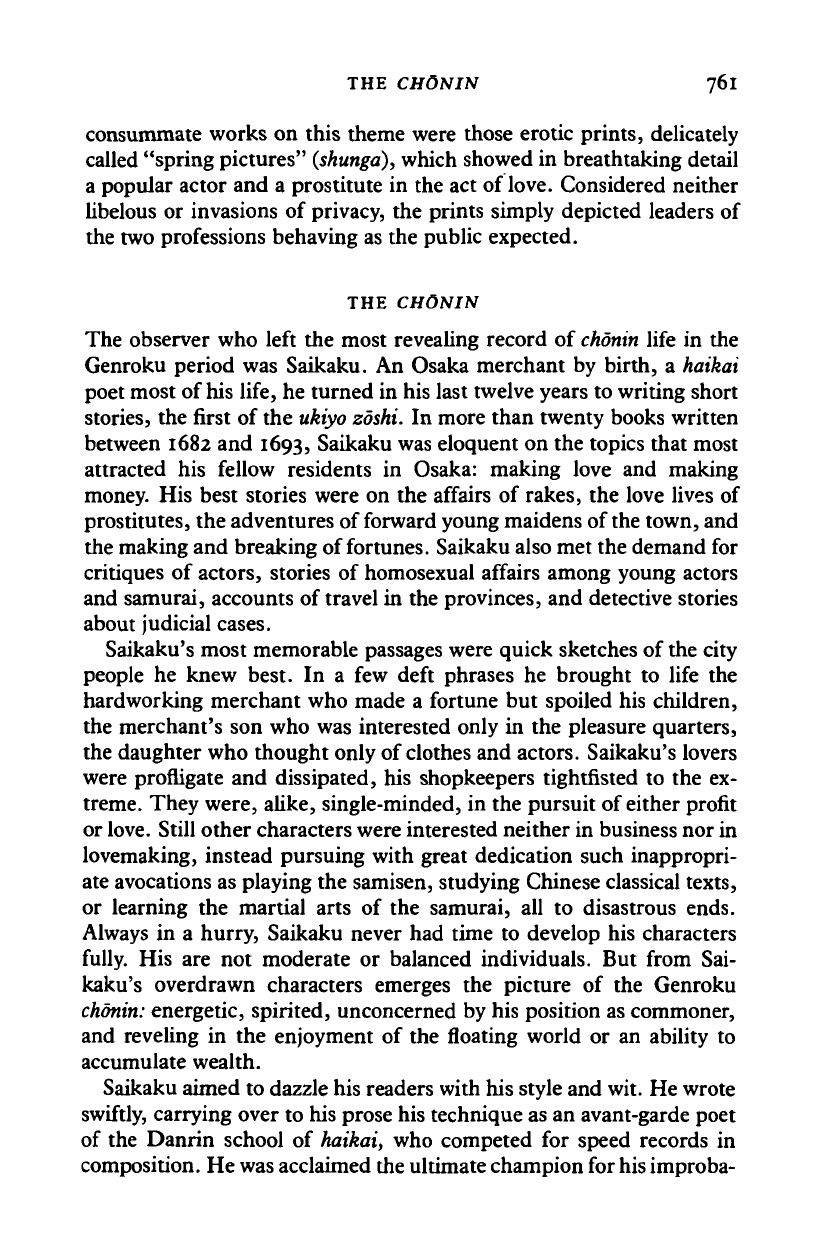
THE CHONIN 761
consummate works on this theme were those erotic prints, delicately
called "spring pictures"
(shunga),
which showed in breathtaking detail
a popular actor and a prostitute in the act of
love.
Considered neither
libelous or invasions of privacy, the prints simply depicted leaders of
the two professions behaving as the public expected.
THE CHONIN
The observer who left the most revealing record of
chonin
life in the
Genroku period was Saikaku. An Osaka merchant by birth, a haikai
poet most of his life, he turned in his last twelve years to writing short
stories, the first of the
ukiyo
zoshi.
In more than twenty books written
between 1682 and 1693, Saikaku was eloquent on the topics that most
attracted his fellow residents in Osaka: making love and making
money. His best stories were on the affairs of rakes, the love lives of
prostitutes, the adventures of forward young maidens of
the
town, and
the making and breaking of fortunes. Saikaku also met the demand for
critiques of actors, stories of homosexual affairs among young actors
and samurai, accounts of travel in the provinces, and detective stories
about judicial cases.
Saikaku's most memorable passages were quick sketches of the city
people he knew best. In a few deft phrases he brought to life the
hardworking merchant who made a fortune but spoiled his children,
the merchant's son who was interested only in the pleasure quarters,
the daughter who thought only of clothes and actors. Saikaku's lovers
were profligate and dissipated, his shopkeepers tightfisted to the ex-
treme. They were, alike, single-minded, in the pursuit of either profit
or
love.
Still other characters were interested neither in business nor in
lovemaking, instead pursuing with great dedication such inappropri-
ate avocations as playing the samisen, studying Chinese classical texts,
or learning the martial arts of the samurai, all to disastrous ends.
Always in a hurry, Saikaku never had time to develop his characters
fully. His are not moderate or balanced individuals. But from Sai-
kaku's overdrawn characters emerges the picture of the Genroku
chonin:
energetic, spirited, unconcerned by his position as commoner,
and reveling in the enjoyment of the floating world or an ability to
accumulate wealth.
Saikaku aimed to dazzle his readers with his style and wit. He wrote
swiftly, carrying over to his prose his technique as an avant-garde poet
of the Danrin school of haikai, who competed for speed records in
composition. He was acclaimed the ultimate champion for
his
improba-
Cambridge Histories Online © Cambridge University Press, 2008
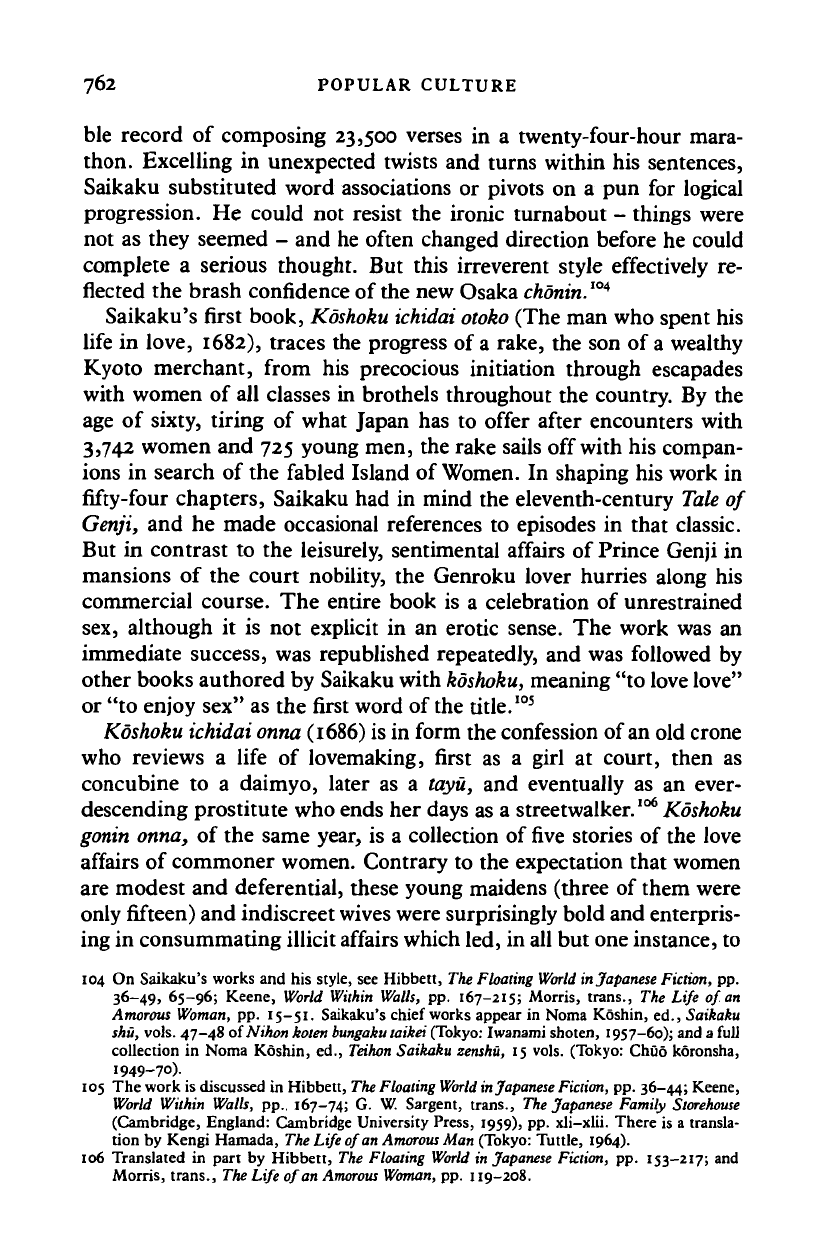
762 POPULAR CULTURE
ble record of composing 23,500 verses in a twenty-four-hour mara-
thon. Excelling in unexpected twists and turns within his sentences,
Saikaku substituted word associations or pivots on a pun for logical
progression. He could not resist the ironic turnabout - things were
not as they seemed - and he often changed direction before he could
complete a serious thought. But this irreverent style effectively re-
flected the brash confidence of the new Osaka
chdnin.
104
Saikaku's first book,
Koshoku ichidai otoko
(The man who spent his
life in love, 1682), traces the progress of
a
rake, the son of a wealthy
Kyoto merchant, from his precocious initiation through escapades
with women of all classes in brothels throughout the country. By the
age of sixty, tiring of what Japan has to offer after encounters with
3,742 women and 725 young men, the rake sails off with his compan-
ions in search of the fabled Island of Women. In shaping his work in
fifty-four chapters, Saikaku had in mind the eleventh-century
Tale of
Genji, and he made occasional references to episodes in that classic.
But in contrast to the leisurely, sentimental affairs of Prince Genji in
mansions of the court nobility, the Genroku lover hurries along his
commercial course. The entire book is a celebration of unrestrained
sex, although it is not explicit in an erotic sense. The work was an
immediate success, was republished repeatedly, and was followed by
other books authored by Saikaku with
koshoku,
meaning "to love love"
or "to enjoy sex" as the first word of the title.
105
Koshoku ichidai onna
(1686) is in form the confession of an old crone
who reviews a life of lovemaking, first as a girl at court, then as
concubine to a daimyo, later as a tayit, and eventually as an ever-
descending prostitute who ends her days as a streetwalker.
106
Koshoku
gonin
onna, of the same year, is a collection of five stories of the love
affairs of commoner women. Contrary to the expectation that women
are modest and deferential, these young maidens (three of them were
only fifteen) and indiscreet wives were surprisingly bold and enterpris-
ing in consummating illicit affairs which led, in all but one instance, to
104 On Saikaku's works and his style, see Hibbett, The Floating
World in
Japanese Fiction, pp.
36-49,
65-96; Keene, World Within Walls, pp. 167-215; Morris, trans., The Life of an
Amorous Woman, pp.
15-51.
Saikaku's chief works appear in Noma Koshin, ed., Saikaku
shit, vols. 47-48 oiNihon koien
bungaku
taikei
(Tokyo:
Iwanami shoten, 1957-60); and a full
collection in Noma Koshin, ed.,
Teihon
Saikaku zenshu, 15 vols. (Tokyo: Chud koronsha,
1949-70).
105 The work is discussed in Hibbett, The Floating
World
in Japanese
Fiction,
pp. 36-44; Keene,
World Within Walls, pp.. 167-74; G. W. Sargent, trans., The Japanese Family
Storehouse
(Cambridge, England: Cambridge University Press, 1959), pp. xli-xlii. There is a transla-
tion by Kengi Hamada, The Life of an
Amorous
Man (Tokyo: Tuttle, 1964).
106 Translated in part by Hibbett, The Floating World in Japanese Fiction, pp. 153-217; and
Morris, trans., The Life of an
Amorous
Woman,
pp. 119-208.
Cambridge Histories Online © Cambridge University Press, 2008
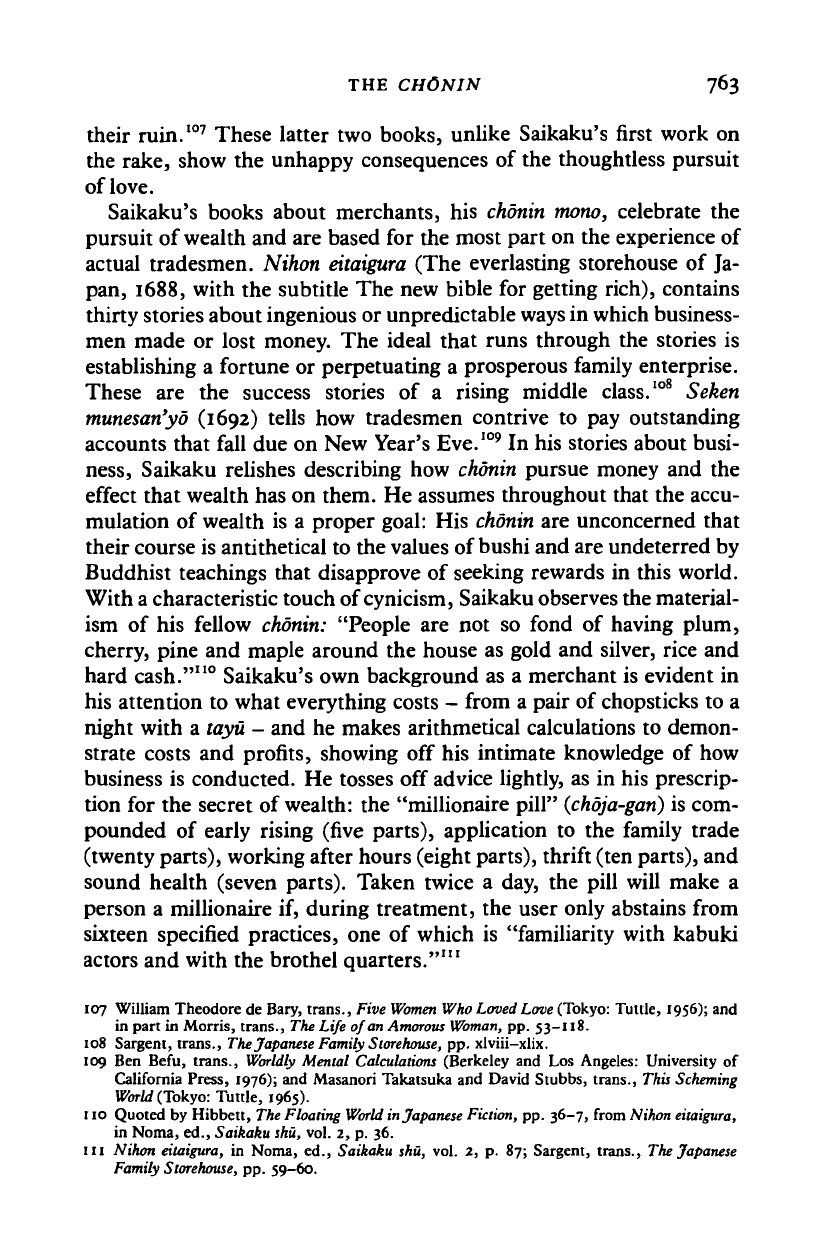
THE CHONIN 763
their ruin.
107
These latter two books, unlike Saikaku's first work on
the rake, show the unhappy consequences of the thoughtless pursuit
of love.
Saikaku's books about merchants, his
chonin
mono,
celebrate the
pursuit of wealth and are based for the most part on the experience of
actual tradesmen. Nihon
eitaigura
(The everlasting storehouse of Ja-
pan, 1688, with the subtitle The new bible for getting rich), contains
thirty stories about ingenious or unpredictable ways in which business-
men made or lost money. The ideal that runs through the stories is
establishing a fortune or perpetuating a prosperous family enterprise.
These are the success stories of a rising middle class.
108
Seken
munesan'yo
(1692) tells how tradesmen contrive to pay outstanding
accounts that fall due on New Year's Eve.
109
In his stories about busi-
ness,
Saikaku relishes describing how
chonin
pursue money and the
effect that wealth has on them. He assumes throughout that the accu-
mulation of wealth is a proper goal: His
chonin
are unconcerned that
their course is antithetical to the values of bushi and are undeterred by
Buddhist teachings that disapprove of seeking rewards in this world.
With
a
characteristic touch of cynicism, Saikaku observes the material-
ism of his fellow
chonin:
"People are not so fond of having plum,
cherry, pine and maple around the house as gold and silver, rice and
hard cash."
110
Saikaku's own background as a merchant is evident in
his attention to what everything costs - from a pair of chopsticks to a
night with a
tayu
- and he makes arithmetical calculations to demon-
strate costs and profits, showing off his intimate knowledge of how
business is conducted. He tosses off advice lightly, as in his prescrip-
tion for the secret of
wealth:
the "millionaire pill"
(choja-gari)
is com-
pounded of early rising (five parts), application to the family trade
(twenty parts), working after hours (eight parts), thrift (ten parts), and
sound health (seven parts). Taken twice a day, the pill will make a
person a millionaire if, during treatment, the user only abstains from
sixteen specified practices, one of which is "familiarity with kabuki
actors and with the brothel quarters."
111
107 William Theodore de Bary, trans., Five
Women
Who Loved Love (Tokyo: Tultle, 1956); and
in part in Morris, trans., The Life of an
Amorous
Woman,
pp. 53—118.
108 Sargent, trans., The Japanese Family
Storehouse,
pp. xlviii-xlix.
109 Ben Befu, trans., Worldly Mental Calculations (Berkeley and Los Angeles: University of
California Press, 1976); and Masanori Takatsuka and David Stubbs, trans., This
Scheming
World
(Tokyo: Tuttle, 1965).
110 Quoted by Hibbett,
The
Floating
World
in Japanese Fiction, pp. 36-7, from Nihon eitaigura,
in Noma, ed., Saikaku shu, vol. 2, p. 36.
in Nihon eitaigura, in Noma, ed., Saikaku shu, vol. 2, p. 87; Sargent, trans., The Japanese
Family
Storehouse,
pp. 59—60.
Cambridge Histories Online © Cambridge University Press, 2008
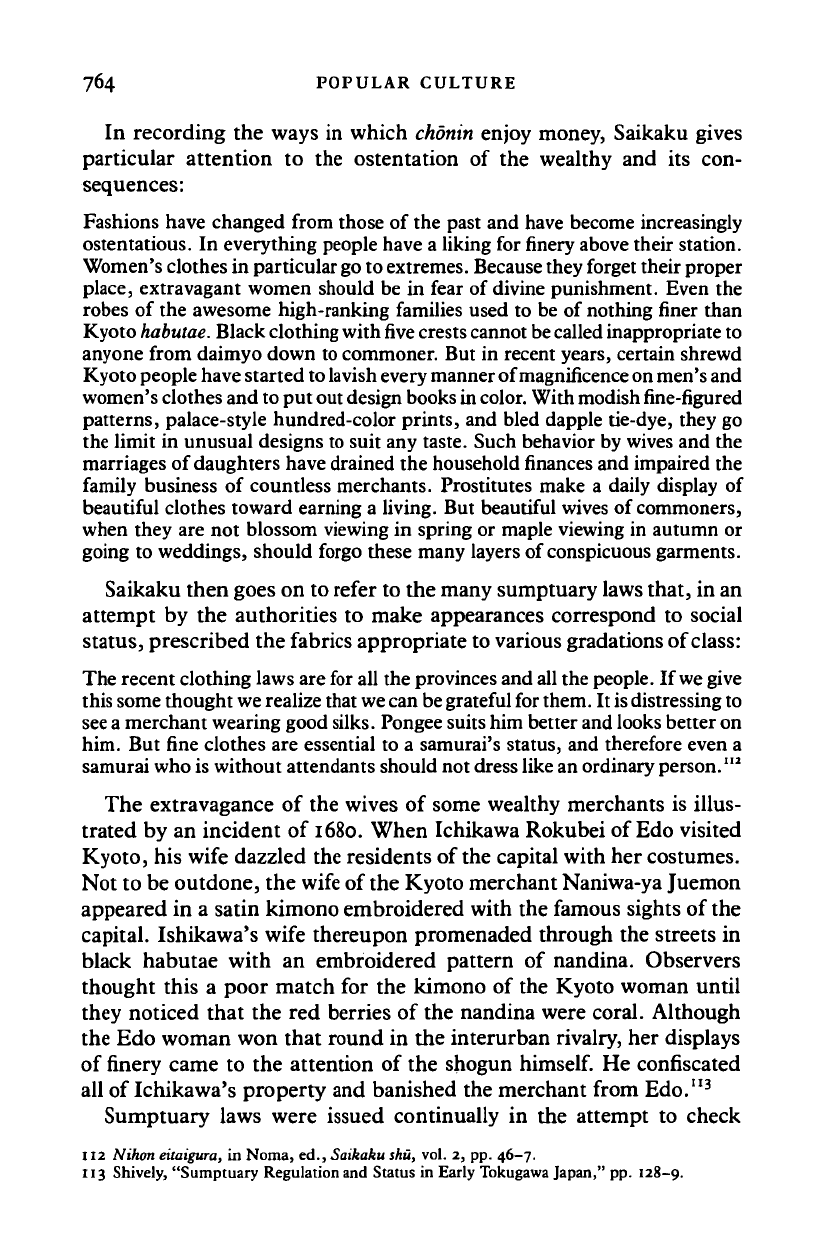
764 POPULAR CULTURE
In recording the ways in which
chonin
enjoy money, Saikaku gives
particular attention to the ostentation of the wealthy and its con-
sequences:
Fashions have changed from those
of
the past
and
have become increasingly
ostentatious.
In
everything people have a liking
for
finery
above their station.
Women's clothes in particular
go
to
extremes.
Because they forget their proper
place, extravagant women should
be in
fear
of
divine punishment. Even
the
robes
of
the awesome high-ranking families used
to be of
nothing finer than
Kyoto
habutae.
Black clothing with
five
crests cannot
be
called inappropriate to
anyone from daimyo down to commoner. But
in
recent years, certain shrewd
Kyoto people have started
to lavish
every manner of magnificence
on
men's and
women's clothes and to put out design books
in
color.
With modish fine-figured
patterns, palace-style hundred-color prints,
and
bled dapple tie-dye, they
go
the limit
in
unusual designs to suit any taste. Such behavior by wives and
the
marriages of daughters have drained the household
finances
and impaired
the
family business
of
countless merchants. Prostitutes make
a
daily display
of
beautiful clothes toward earning
a
living. But beautiful wives
of
commoners,
when they
are not
blossom viewing
in
spring
or
maple viewing
in
autumn
or
going
to
weddings, should forgo these many layers
of
conspicuous garments.
Saikaku then goes
on
to refer
to
the many sumptuary laws that,
in an
attempt
by the
authorities
to
make appearances correspond
to
social
status,
prescribed
the
fabrics appropriate
to
various gradations of
class:
The recent clothing laws are for all the provinces and all the people. If we give
this some thought
we
realize that
we
can
be
grateful for
them.
It
is
distressing to
see a
merchant wearing good
silks.
Pongee suits him better and looks better on
him.
But
fine clothes are essential
to a
samurai's status,
and
therefore even
a
samurai who is without attendants should not dress like an ordinary person."
2
The extravagance of the wives of some wealthy merchants is illus-
trated by an incident of 1680. When Ichikawa Rokubei of Edo visited
Kyoto, his wife dazzled the residents of the capital with her costumes.
Not to be outdone, the wife of
the
Kyoto merchant Naniwa-ya Juemon
appeared in a satin kimono embroidered with the famous sights of the
capital. Ishikawa's wife thereupon promenaded through the streets in
black habutae with an embroidered pattern of nandina. Observers
thought this a poor match for the kimono of the Kyoto woman until
they noticed that the red berries of the nandina were coral. Although
the Edo woman won that round in the interurban rivalry, her displays
of finery came to the attention of the shogun
himself.
He confiscated
all of Ichikawa's property and banished the merchant from Edo.
113
Sumptuary laws were issued continually in the attempt to check
112 Nihon eilaigura,
in
Noma, ed., Saikaku shu,
vol. 2, pp. 46-7.
113 Shively, "Sumptuary Regulation and Status
in
Early Tokugawa Japan,"
pp.
128-9.
Cambridge Histories Online © Cambridge University Press, 2008
